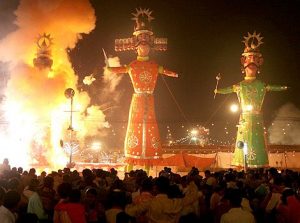Dussehra is one of the most important Hindu festivals. The festival is celebrated for the victory of good over evil. It comes in the second fortnight of the month of “A Sauj” according to lunar calendar and in the month of October of English calendar every year.
Reasons for the celebration of Dussehra festival:
Dussehra is so called because it is celebrated on the tenth day. It is also said Dussehra represents ten days of penance for removing ten different sins. In the Northern parts of India, it is performed to celebrate the victory of Rama over Ravana, the ten headed ‘Asur’. In many parts of India, it is performed as “Navratri” or “Durga Puja” festival. For nine days and nights Goddess Durga fought with several demons and came out victoriously on the ninth day, the tenth day is called Vijayadashmi or Victorious tenth day. On this day jubilation, joy and happiness is shared amongst all the Hindus. Thus this festival is performed mainly on three days. The eighth day as “Durga Ashtami”, and ninth day as “Mahanavami” and the tenth victorious day as “Vijayadashmi”. Yet another reason for celebrating this festival is Pandavas exile of living incognito was over on this day.
Method of celebration of Dussehra in different parts of our country:
 During these festive days, the epic story of Ramayana is depicted throughout North in the form of ballets, stage shows, dramas popularly known as “Rama Lilas”. The children are always eager to go in the night to see such dramas and they enjoy and learn a great deal of life of Rama, his mission, his truthful nature, his duty and noble character.
During these festive days, the epic story of Ramayana is depicted throughout North in the form of ballets, stage shows, dramas popularly known as “Rama Lilas”. The children are always eager to go in the night to see such dramas and they enjoy and learn a great deal of life of Rama, his mission, his truthful nature, his duty and noble character.
Thus on the final day, that is the day of victory – effigies of Ravana, Khumbhkaran and Meghnath are burnt with a fine display of fireworks. The whole Ramlila Ground of every city town and public place is filled with men women and children. A big fair is arranged and lightning and gay festive show brings lots of pleasure, hustle bustle, fun and frolic, mirth and gaiety in the environs.
In Bengal, idols of Goddess Durga are made. These beautiful idols are worshipped for nine days. The rituals of the last three days Durga Ashtami, Maha Navami and Vijayadashmi are most important days of the function. On the last day, these idols are taken out in the form of procession with Prayers, Bhajans and Kirtans to be immersed in rivers and lakes. In South India, performance of “Devi Nav Ratans” or worship of Goddess Durga for nine days is done at several temples, public places and houses. In each of the South Indian homes, assortation of dolls and images is a lively and imaginative way is a treat for the eyes. People take pride in exhibiting the rich and great artistic taste in arranging “Courts of Dolls”.
Enjoying the Festival on Vijaya Dashmi day:
On the main festival day, people take bath and worship Goddess Durga in the houses & temples. Vehicles and arms are also worshipped in certain parts of the country. People make and enjoy delicious food in the houses, wear new clothes and visit temples. They move out joyfully meeting friends and relatives and exchange greetings with all in a pleasureful way.
In short, it is a festival of triumph of good over evil. Probably it is one of the most important festivals where religious, social and cultural sentiments are exhibited over the whole country into a single unit.